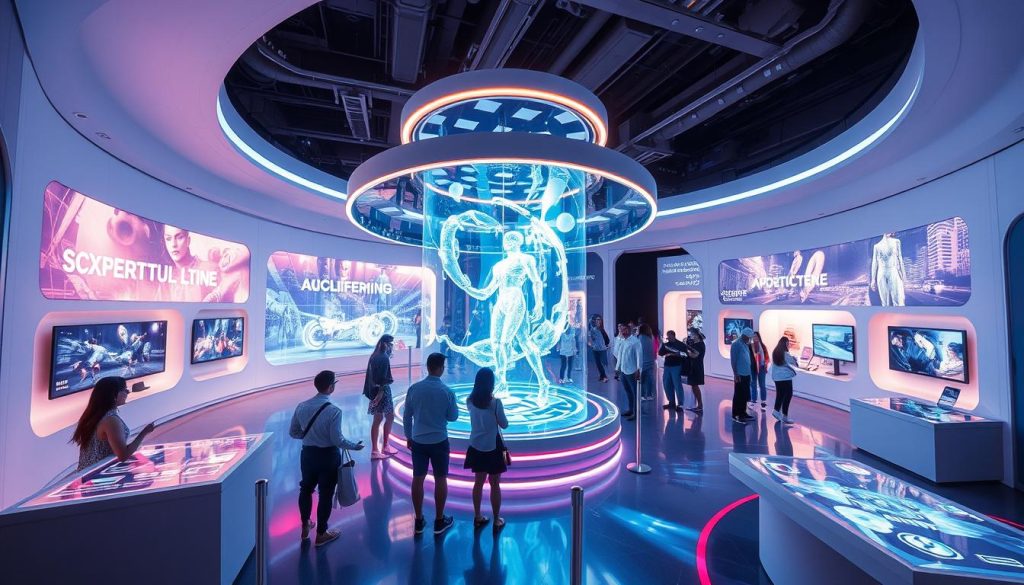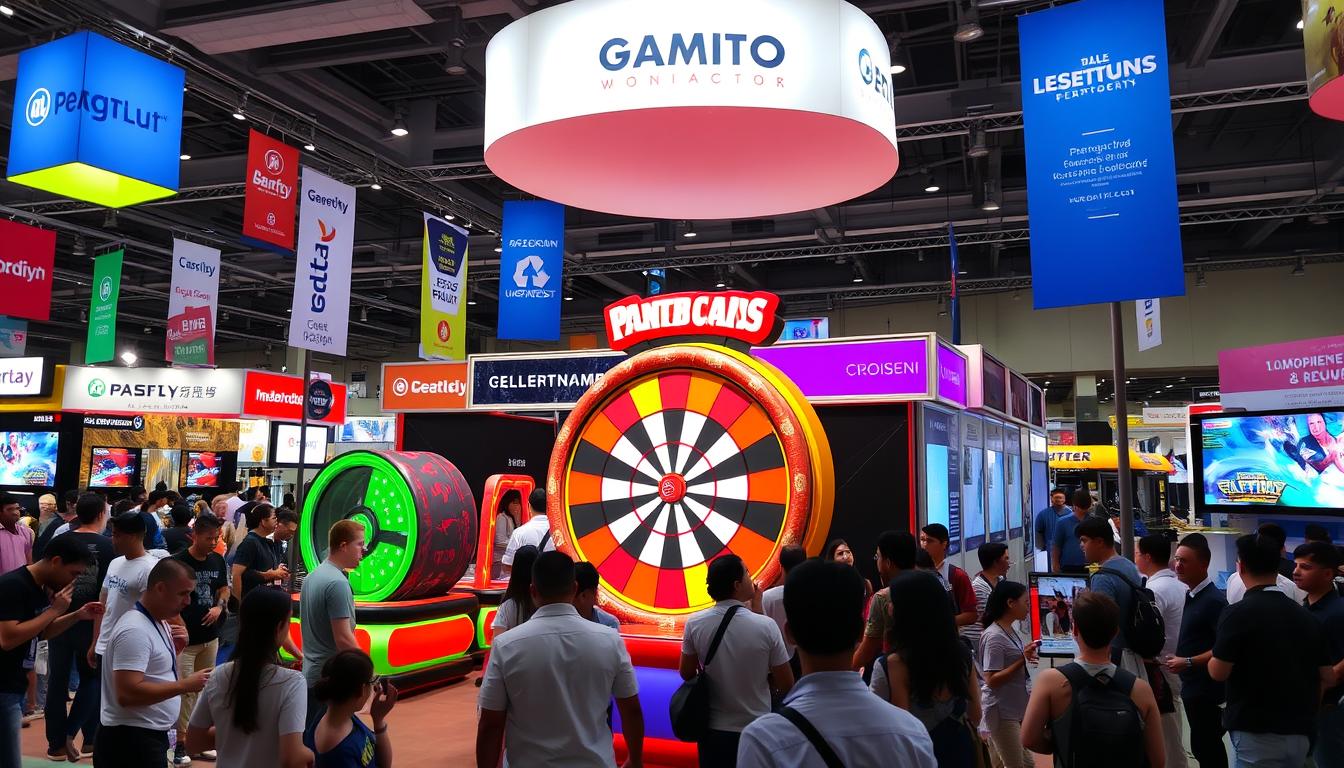In the dynamic world of trade shows and expos, standing out from the crowd is crucial. A successful expo marketing strategy hinges on creating memorable, engaging experiences for attendees. At the heart of this approach lies the power of branded games and experiential marketing techniques.
Innovative brands are discovering that interactive elements can significantly boost their impact at expos. By incorporating branded games into their booth design, companies can captivate visitors and leave a lasting impression. These games not only entertain but also educate attendees about products and services in a fun, engaging manner.
Experiential marketing takes center stage in modern expo strategies. It’s about creating immersive environments that allow potential customers to interact with your brand on a deeper level. This approach transforms passive observers into active participants, fostering stronger connections and increasing the likelihood of post-event follow-ups.
Key Takeaways
- Branded games enhance booth engagement and memorability
- Experiential marketing creates deeper connections with attendees
- Interactive elements boost overall expo marketing effectiveness
- Immersive experiences lead to stronger brand recall
- Engaging activities increase post-event follow-up potential
Understanding the Foundation of Modern Expo Marketing
Expo marketing has undergone a significant transformation in recent years. The digital age has ushered in new ways to create interactive brand experiences that captivate audiences and drive engagement. Let’s explore the key aspects of modern expo marketing and how they shape successful strategies.
Defining Exhibition Marketing in Today’s Digital Age
Exhibition marketing now blends traditional face-to-face interactions with digital elements. It’s about creating memorable experiences that extend beyond the physical booth space. Brands use technology to enhance trade show engagement, offering virtual tours, augmented reality displays, and interactive demos.
The Evolution of Trade Show Marketing
Trade shows have evolved from simple product displays to immersive brand experiences. The focus has shifted from passive observation to active participation. Gamification for branding has become a popular tool, turning attendees into active participants rather than passive observers.
Core Components of Successful Expo Strategies
Successful expo strategies now incorporate:
- Digital integration for seamless experiences
- Interactive displays that encourage hands-on exploration
- Social media integration for real-time engagement
- Data collection tools for personalized follow-ups
| Traditional Approach | Modern Approach |
|---|---|
| Static displays | Interactive touchscreens |
| Printed brochures | Digital content hubs |
| Business card exchanges | QR code lead capture |
| One-size-fits-all presentations | Personalized demos |
By embracing these modern elements, brands can create unforgettable expo experiences that resonate with attendees long after the event ends.
Pre-Event Planning and Goal Setting
Successful expo marketing starts long before the event kicks off. Careful planning and clear goals are crucial for making the most of your trade show presence. Let’s dive into key strategies for pre-event preparation and goal-setting.
First, define your objectives. Are you aiming to generate leads, launch a new product, or boost brand awareness? Your goals will shape your entire expo strategy. For example, if lead generation is your focus, prioritize expo visitor engagement strategies that encourage attendees to share their contact information.
Next, create a timeline for your brand activation events. This helps ensure all tasks are completed on schedule, from booth design to staff training. A well-organized timeline might look like this:
| Timeframe | Task |
|---|---|
| 3 months before | Finalize booth design and order materials |
| 2 months before | Develop marketing materials and giveaways |
| 1 month before | Train staff on expo engagement techniques |
| 2 weeks before | Confirm all logistics and shipping details |
Remember to align your expo strategy with your overall marketing goals. This ensures your brand activation events contribute to your broader business objectives. By setting clear targets and planning meticulously, you’ll be well-prepared to make a lasting impression at your next trade show.
Branded Games: The Key to a Successful Expo Marketing Strategy
Branded games are becoming a cornerstone of successful expo marketing strategies. These interactive elements create immersive expo exhibits that leave lasting impressions on visitors. By incorporating games into your booth, you can foster memorable brand interactions that set you apart from competitors.
Interactive Gaming Elements for Visitor Engagement
Interactive gaming elements draw visitors to your booth and keep them engaged. Virtual reality experiences, touchscreen quizzes, and augmented reality scavenger hunts are popular choices. These games not only entertain but also educate attendees about your products or services in a fun, interactive way.
Digital vs Physical Gaming Experiences
Both digital and physical gaming experiences offer unique benefits for creating memorable brand interactions. Digital games, like mobile apps or VR simulations, provide high-tech appeal and data collection opportunities. Physical games, such as oversized board games or skill-based challenges, offer tangible experiences that can be equally engaging.
| Digital Games | Physical Games |
|---|---|
| VR product demonstrations | Giant Jenga with branded blocks |
| Touchscreen product quizzes | Branded mini-golf course |
| AR treasure hunts | Prize wheel spin |
Measuring Gaming Activity ROI
To justify the investment in branded games, it’s crucial to measure their impact. Track metrics such as visitor engagement time, lead generation, and post-event survey responses. Analyze this data to refine your gaming strategy for future expos, ensuring your immersive expo exhibits continue to create valuable, memorable brand interactions.
Designing an Immersive Booth Experience
Creating immersive expo exhibits is key to standing out at trade shows. A well-designed booth can draw visitors in and leave a lasting impression. Let’s explore how to craft a space that captivates attendees and showcases your brand effectively.
Spatial Planning and Traffic Flow
Smart layout is crucial for interactive brand experiences. Plan your booth with clear pathways and zones for different activities. This helps guide visitors through your exhibit smoothly, ensuring they engage with all your key messages and products.
Visual Branding Elements
Your booth should be a visual feast that reflects your brand identity. Use bold graphics, eye-catching signage, and cohesive color schemes. These elements work together to create a memorable space that visitors will remember long after the expo ends.
Technology Integration
Incorporating technology can take your booth from standard to spectacular. Interactive touchscreens, virtual reality experiences, and augmented reality demonstrations can all enhance visitor engagement. These tech-driven features not only attract attention but also provide valuable customer service opportunities, allowing you to showcase products in innovative ways.
By focusing on these three areas, you’ll create a booth that not only looks great but also functions as a powerful marketing tool. Remember, the goal is to design a space where visitors can fully immerse themselves in your brand story and offerings.
Lead Generation and Data Collection Strategies
Successful expo marketing hinges on effective lead generation and data collection. Trade show engagement is key to capturing valuable visitor information and building lasting connections. By implementing smart expo visitor engagement strategies, businesses can maximize their return on investment and nurture potential clients long after the event concludes.
One powerful approach is to use interactive technologies to gather data. Digital surveys, touchscreen kiosks, and mobile apps can collect visitor details while providing an engaging experience. These tools not only streamline data collection but also enhance the overall booth experience, making it more memorable for attendees.
Another effective strategy is to offer incentives for information sharing. Contests, giveaways, or exclusive content access can motivate visitors to provide their contact details willingly. This approach creates a win-win situation, where attendees receive immediate value while exhibitors gain valuable leads.
“The key to successful lead generation at expos is to create value for visitors in exchange for their information.”
To optimize lead quality, consider implementing a lead scoring system. This helps prioritize follow-ups and ensures that sales teams focus on the most promising prospects. Email marketing can be an effective tool for nurturing these leads post-event, maintaining engagement and moving prospects through the sales funnel.
| Strategy | Benefits | Implementation Difficulty |
|---|---|---|
| Interactive Tech | High engagement, efficient data collection | Medium |
| Incentives | Increased participation, willing information sharing | Low |
| Lead Scoring | Improved follow-up efficiency, higher conversion rates | High |
By combining these strategies, exhibitors can create a comprehensive approach to lead generation and data collection that enhances trade show engagement and drives business growth.
Staff Training and Customer Interaction Protocols
The success of your expo marketing strategy hinges on your team’s ability to create memorable brand interactions. A well-trained staff is crucial for delivering exceptional experiential marketing that leaves a lasting impression on visitors.
Selecting the Right Team
Choose staff members who embody your brand values and possess strong interpersonal skills. Look for individuals who are enthusiastic, knowledgeable, and capable of thinking on their feet. These qualities are essential for creating authentic connections with potential clients at your booth.
Communication Guidelines
Establish clear communication protocols to ensure consistent messaging across your team. Train your staff to engage visitors effectively, ask open-ended questions, and tailor their approach to each individual’s needs. This personalized interaction is key to creating memorable experiences that resonate with your target audience.
Performance Metrics
Set measurable goals for your team’s performance to gauge the effectiveness of your experiential marketing efforts. Consider metrics such as:
- Number of qualified leads generated
- Average engagement time per visitor
- Conversion rates from booth visits to follow-up meetings
- Customer satisfaction scores based on post-event surveys

| Metric | Target | Actual |
|---|---|---|
| Qualified Leads | 100 | 125 |
| Avg. Engagement Time | 5 minutes | 7 minutes |
| Conversion Rate | 20% | 25% |
| Customer Satisfaction | 4.5/5 | 4.7/5 |
By focusing on these key areas, you’ll empower your team to deliver exceptional experiential marketing that creates lasting impressions and drives meaningful results for your brand at expos and trade shows.
Social Media Integration and Digital Amplification
Expo marketing reaches new heights when paired with social media and digital strategies. Brands now extend their reach beyond the event floor, creating lasting impressions through online channels. This approach taps into the power of gamification for branding, allowing companies to engage audiences before, during, and after expos.
Interactive brand experiences take center stage in this digital era. Exhibitors craft shareable moments that attendees eagerly post on their social networks. This organic spread amplifies the brand’s message, reaching potential customers who couldn’t attend in person. Tailoring content to audience segments ensures these digital touchpoints resonate with various consumer groups.
Live streaming has become a game-changer for expo marketing. Brands now broadcast key events, product launches, and interactive sessions to global audiences. This real-time engagement creates a sense of FOMO (fear of missing out), driving online participation and boosting brand visibility.
| Digital Strategy | Benefits | Implementation Tips |
|---|---|---|
| Hashtag Campaigns | Increased brand visibility, user-generated content | Create unique, memorable hashtags; encourage use with contests |
| Virtual Reality Tours | Immersive experiences for remote audiences | Offer 360-degree booth tours; showcase products in VR |
| Social Media Walls | Real-time engagement, social proof | Display curated posts at the booth; feature attendee content |
By integrating these digital strategies, brands create a seamless blend of physical and virtual experiences. This approach not only enhances expo presence but also builds lasting connections with audiences long after the event concludes.
Interactive Technologies and Virtual Reality Implementation
Expo marketing has entered a new era with immersive expo exhibits and interactive brand experiences. These cutting-edge technologies are transforming how companies engage with attendees, creating memorable interactions that leave lasting impressions.
AR/VR Solutions
Augmented Reality (AR) and Virtual Reality (VR) are game-changers for immersive expo exhibits. AR overlays digital content onto the real world, while VR transports users to entirely virtual environments. Both technologies offer unique ways to showcase products, demonstrate services, and create interactive brand experiences that captivate audiences.

Mobile Integration
Smart devices are integral to modern expo strategies. Mobile apps can guide attendees through exhibits, provide real-time information, and facilitate networking. QR codes and NFC technology enable seamless interactions between physical displays and digital content, enhancing the overall expo experience.
Digital Touchpoints
Interactive kiosks, touchscreens, and digital signage create engaging touchpoints throughout the expo. These digital interfaces allow visitors to explore product catalogs, watch demos, and even place orders on the spot. By integrating these elements, brands can create a cohesive and immersive journey for attendees.
| Technology | Application | Benefit |
|---|---|---|
| AR/VR | Product Demos | Immersive Experiences |
| Mobile Apps | Navigation & Info | Personalized Guidance |
| Digital Kiosks | Self-Service | Engagement & Data Collection |
By leveraging these interactive technologies, brands can create immersive expo exhibits that not only showcase their products but also provide memorable, interactive brand experiences that resonate with attendees long after the event concludes.
Budget Allocation and ROI Tracking
Managing your expo budget wisely is key to a successful expo marketing strategy. Smart spending can boost your visitor engagement and maximize returns. Let’s break down the essentials of budget planning and measuring success.
Cost Analysis Framework
Start by listing all your expo expenses. This includes booth design, staff travel, marketing materials, and tech tools. Compare these costs to your expected benefits. This helps you see where your money is best spent. Creating a targeted approach can lead to better ROI for your expo efforts.
Investment Priority Areas
Focus your budget on areas that drive results. Interactive displays and branded games often lead to high expo visitor engagement. Staff training is another smart investment. Well-prepared team members can turn curious visitors into solid leads. Don’t forget to set aside funds for follow-up marketing after the event.
Performance Measurement Tools
Track your success with the right tools. Use lead scanning apps to count and qualify new contacts. Set up surveys to gather feedback on your booth experience. Analytics software can help you measure online engagement from your expo activities. These insights will guide your future expo strategies and budget decisions.
FAQ
What are the key components of a successful expo marketing strategy?
A successful expo marketing strategy includes interactive brand experiences, engaging booth design, branded games, well-trained staff, effective lead generation techniques, and integration of digital technologies. It’s crucial to focus on creating memorable brand interactions and leveraging experiential marketing to stand out from the competition.
How can branded games enhance my expo presence?
Branded games can significantly boost your expo presence by increasing visitor engagement, creating a fun and interactive atmosphere, and making your brand more memorable. They provide an excellent opportunity for gamification for branding, helping to attract more visitors to your booth and collect valuable data while offering an enjoyable experience.
What’s the importance of pre-event planning for expos?
Pre-event planning is crucial for expo success. It involves setting clear goals, designing brand activation events, developing expo visitor engagement strategies, and preparing your team. Proper planning ensures you maximize your investment, create a cohesive brand experience, and are fully prepared to engage with potential clients effectively.
How can I measure the ROI of my expo marketing efforts?
Measuring ROI for expo marketing involves tracking various metrics such as lead quality and quantity, booth traffic, engagement levels with interactive brand experiences, social media mentions, and post-event sales conversions. Utilize digital tools to collect data, set clear KPIs before the event, and conduct thorough post-event analysis to evaluate the success of your strategy.
What role does technology play in creating immersive expo exhibits?
Technology plays a crucial role in creating immersive expo exhibits. It can include AR/VR solutions, interactive touchscreens, mobile integrations, and digital displays. These technologies enhance visitor engagement, provide unique experiences, and help showcase products or services in innovative ways, making your booth more attractive and memorable.
How can I effectively train my staff for expo success?
Effective staff training for expos involves selecting the right team members, establishing clear communication guidelines, and setting performance metrics. Focus on teaching your team about your products/services, how to engage visitors effectively, and how to facilitate interactive brand experiences. Regular briefings and debriefings during the event can help maintain high performance.
What are some effective lead generation strategies for expos?
Effective lead generation strategies at expos include using interactive brand experiences to capture visitor information, implementing digital check-ins at your booth, offering valuable content in exchange for contact details, and utilizing gamification for branding with prize incentives. Always ensure your methods align with data protection regulations and provide value to the visitors.
How can I integrate social media into my expo marketing strategy?
Integrating social media into your expo strategy can involve creating event-specific hashtags, running live social media contests, sharing real-time updates and behind-the-scenes content, and encouraging visitors to share their experiences online. This approach extends your reach beyond the physical event and enhances overall brand visibility and engagement.


